
Allium crispum is a species of wild onion known by the common name crinkled onion. It is endemic to California, where it grows along the Central Coast in the Coast Ranges and in the Santa Monica Mountains, often in clays and serpentine soils. It is a perennial herb that is typically found in the foothill woodlands and valley grasslands of California.

Claytonia exigua is a species of wildflower known by the common names serpentine springbeauty and pale claytonia, in the family Montiaceae.

Clarkia cylindrica is a species of flowering plant in the evening primrose family known by the common name speckled fairyfan, or speckled clarkia.

Chaenactis artemisiifolia, with the common name white pincushion, is a species of flowering plant in the daisy family. It is native to the coastal Peninsular Ranges of Southern California and Baja California, in the chaparral and woodlands.

Calycadenia multiglandulosa is a species of flowering plant in the family Asteraceae, known by the common names sticky calycadenia and sticky western rosinweed. It is endemic to California, where it is a common in the Coast Ranges and in the Sierra Nevada Foothills from Shasta County to Kern County.
Chylismia heterochroma is a species of evening primrose known by the common name Shockley's evening primrose. It is native to the desert slopes and woodland of eastern California and Nevada. It is a hairy, glandular annual herb growing a spindly stem up to a meter tall. There is a thick basal rosette of leaves which are mostly oval in shape and several centimeters in length, and generally no leaves higher up the stem. The inflorescence produces several small flowers with four oval petals just a few millimeters long and lavender in color with yellow-tinted bases. The fruit is a club-shaped capsule roughly a centimeter long.
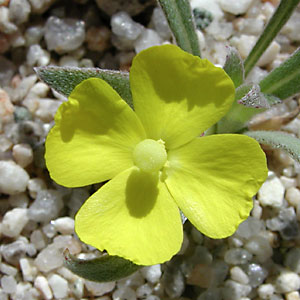
Camissoniopsis pallida is a low growing, yellow-flowered annual plant in the evening primrose family, Onagraceae. It is known by the common names pale primrose or pale yellow suncup. It is native to the desert and scrub habitat of the region where Arizona, California, and Nevada meet. It is a roughly hairy annual herb growing in a low patch on the ground, sometimes producing an erect stem from the basal rosette. The herbage is gray-green to reddish green. The leaves are lance-shaped and up to 3 centimeters long. The nodding inflorescence produces flowers with yellow petals 2 to 13 millimeters long, each with small red markings near the bases. The fruit is a straight to tightly coiled capsule.
Camissonia pusilla is a species of evening primrose known by the common name little wiry suncup. It is native to the western United States from California to Idaho, where it grows in sagebrush and other habitat. It is a petite, hairy, glandular annual herb producing very slender erect stems up to about 22 centimeters in maximum height. The leaves linear with toothed edges and 1 to 3 centimeters long. The nodding inflorescence produces flowers with yellow petals 2 or 3 millimeters long and usually spotted with red near the bases. The fruit is a straight or coiling capsule up to 3 centimeters long.

Campanula griffinii is a species of bellflower known by the common name Griffin's bellflower. It is endemic to California, where it grows in the North and Central Coast Ranges in chaparral habitat on serpentine soils. This is an annual herb producing a thin, erect stem up to 20 centimeters tall. The leathery leaves are linear in shape, toothed along the edges, and less than a centimeter long. The stem and foliage are sometimes reddish in color and may have stiff hairs. The small, cylindrical flower is pale blue to white and less than 4 millimeters long. The fruit is an oblong, ribbed capsule.
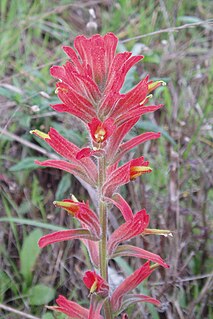
Castilleja subinclusa is a species of Indian paintbrush known by the common names longleaf Indian paintbrush and Franciscan paint brush.
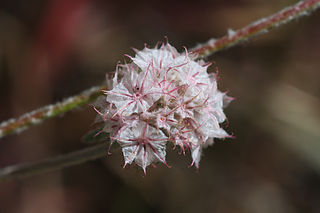
Chorizanthe membranacea is a species of flowering plant in the buckwheat family known by the common name pink spineflower. It is native to Oregon and California, where it is widespread and in some areas quite common. It can be found in a wide variety of habitats.
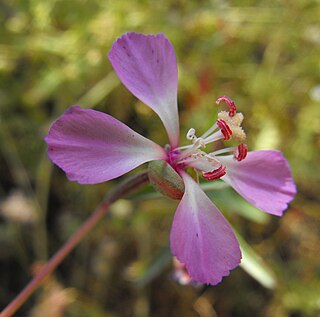
Clarkia delicata is a rare species of flowering plant in the evening primrose family known by the common names Campo clarkia and delicate clarkia. It is native to northern Baja California and adjacent San Diego County, California, where it grows in the woodland and chaparral of the Peninsular Ranges. This is an annual herb producing an erect stem just over half a meter in maximum height. The leaves are oval or widely lance-shaped, up to 4 centimeters long, and borne on very short petioles. The top of the stem is occupied by the inflorescence, in which the lower flowers open while the upper buds hang closed. The sepals remain fused as the flower blooms from one side. Each unlobed oval petal is about a centimeter long and pink to pinkish-lavender. There are 8 stamens, some with large orange anthers and some with smaller, paler anthers. There is also a protruding stigma with four large, fuzzy lobes.

Clarkia mildrediae is an uncommon species of flowering plant in the evening primrose family known by the common name Mildred's clarkia. It is endemic to California, where it is known from the forests of the southernmost Cascade Range and northern Sierra Nevada. It is an erect annual herb often exceeding half a meter in height. The oval leaves grow up to 6 centimeters long and are borne on petioles of up to 4 centimeters. The inflorescence bears opening flowers and hanging, pointed flower buds. As the bud opens the sepals all separate instead of remaining fused as those of many other Clarkia species do. The triangular to semicircular petals are about 2 centimeters long and lavender to bright reddish-purple, sometimes with dark speckling. There are 8 stamens with anthers all alike, and a protruding stigma.
Clarkia tembloriensis is a rare species of flowering plant in the evening primrose family, known by the common name Temblor Range clarkia and belonging to the Onagraceae family.
Claytonia nevadensis, known by the common names Sierra springbeauty and Sierra Nevada claytonia, is a species of wildflower in the family Montiaceae. The evolutionary relationship of Claytonia nevadensis to other claytonias is a subject of debate and ongoing genetic studies. Sierra springbeauties are diploid with a chromosome base number of x = 7
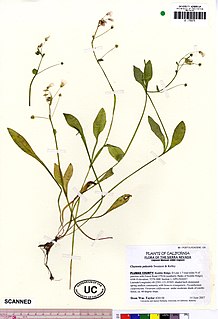
Claytonia palustris is a species of wildflower in the family Montiaceae known by the common names Jonesville springbeauty and marsh claytonia.
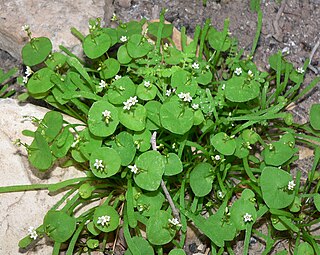
Claytonia parviflora is a species of wildflower in the family Montiaceae known by the common name Indian lettuce. It is native to western North America from southwestern Canada to northwestern Mexico, where it is found in many types of habitat, particularly areas that are moist in the spring. This is an annual herb growing in a clump or spreading to a maximum length of about 30 centimeters. The basal leaves are linear, often with an indistinct petiole. Some races may have lance-shaped blades on long, tapering petioles. There are also leaves on the flower stem which may be similar in shape or may be rounded or squared and sometimes fuse together to create a bowl around the stem. The herbage is green to pink in color. The inflorescence is a cluster of up to 40 small flowers, each with petals a few millimeters long and white to pink-tinted, or deep pink in color. The largest flowers, up to 1 cm in diameter, are found in Claytonia parviflora subsp. grandiflora, which is a subspecies endemic to the foothills and lower slopes of the western Sierra Nevada of North America. Together with Claytonia perfoliata and Claytonia rubra, Claytonia parviflora comprises what is almost certainly a polyploid pillar complex

Claytonia rubra is a species of wildflower in the family Montiaceae known by the common names redstem springbeauty and erubescent miner's lettuce. It is native to western North America from southwestern Canada to the Transverse Range of California, U. S. A. (and east to the Black Hills of South Dakota, U. S. A., where it is found in coniferous forests and shrublands. This is an annual herb with stems up to about 15 centimeters long. Some individuals may overwinter as biennials. The basal leaves have small rounded to diamond-shaped blades on long, tapering petioles. There are also leaves on the stem which may be rounded or squared and sometimes fuse together to create a bowl around the stem. All the leaves possess blunt tips according to published descriptions and taxonomic treatments. The herbage is red or pink in color at all stages of development. The inflorescence is a dense cluster of up to 30 tiny flowers, each with petals less than 4 millimeters long and white to pink-tinted in color. Together with Claytonia perfoliata and Claytonia parviflora, Claytonia rubra comprises what is almost certainly a polyploid pillar complex based on three diploid species, each occupying a definitive ecological niche
Claytonia saxosa, known by the common name Brandegee's springbeauty, is a species of wildflower in the family Montiaceae.

Leptosiphon androsaceus is a species of flowering plant in the phlox family known by the common name false babystars.
















